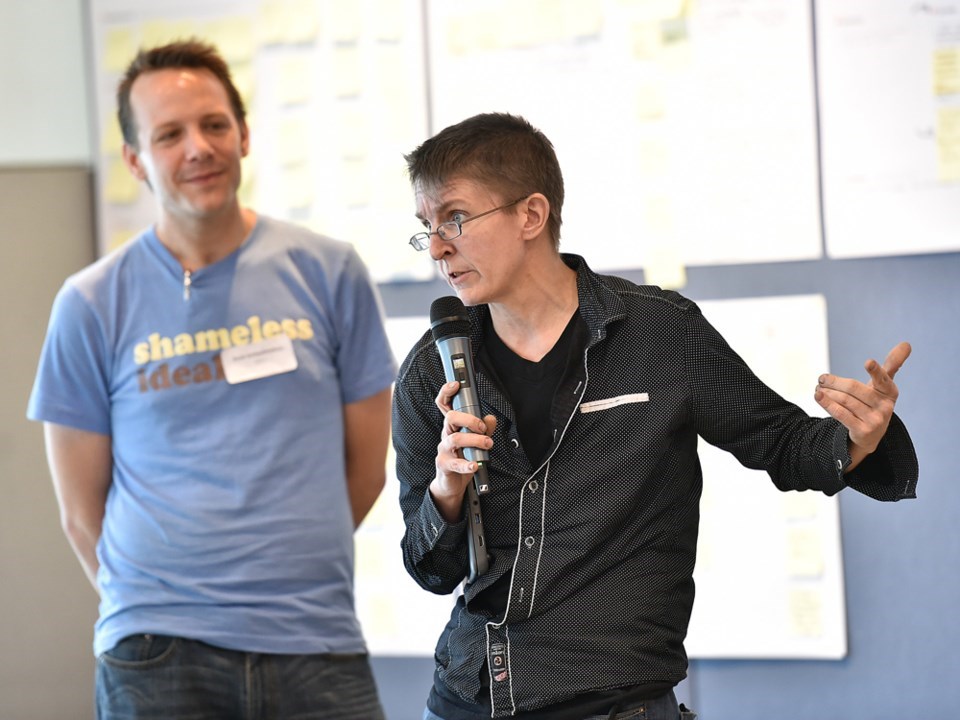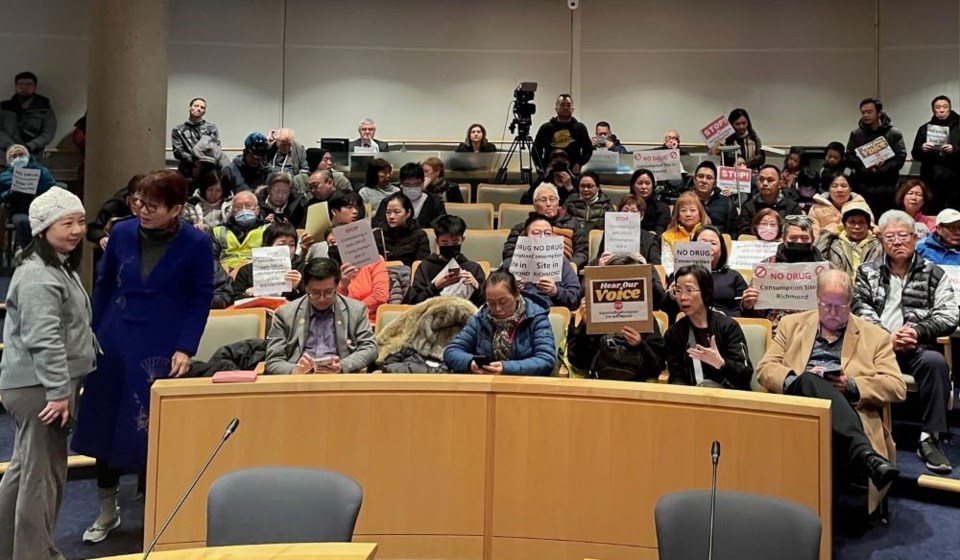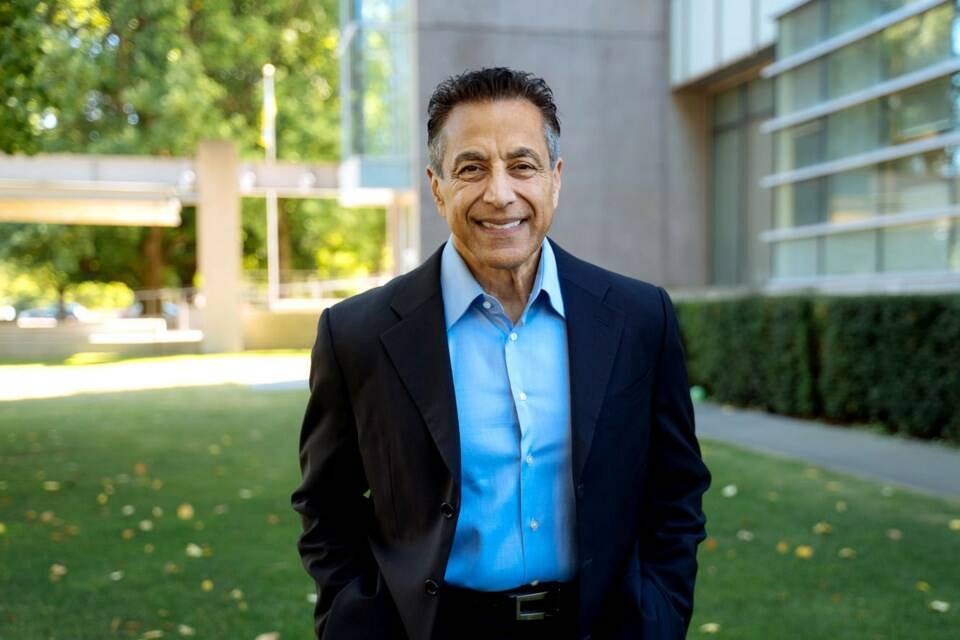For all the in the provincial government’s implementation of overdose prevention and supervised consumption sites, it did not look at one key aspect that boiled over into controversy most recently in Richmond: that is, how exactly is the establishment of such sites determined in the first place?
If, as the auditor found, health authorities lacked guidance and minimum service standards from the Ministry of Mental Health and Addictions in operating the sites, they surely lacked them in establishing them, assert two proponents of such services in Richmond, where 26 people died of a suspected drug poisoning or overdose in 2023.
“I was aware there was no threshold; I was aware that there was no matrix; I was aware that there was no established criteria,” said Richmond city councillor Kash Heed.
“I was absolutely aware of the fact this was highly subjective and highly political,” said Heed.
“It blew my mind,” said Heed who, earlier this year, proposed a motion for council to help explore overdose prevention services, including a supervised consumption site at Richmond General Hospital, with Vancouver Coastal Health Authority.
And it also came as no surprise to drug use policy advisor Karen Ward when the health authority ultimately declined to implement a site in Richmond following vocal protests at city hall.
“It's a real abdication of their leadership role. And this is a perfect example of it. The auditor nails it; it’s that there is no process because it's completely ad hoc,” said Ward.
According to Ward, the “only legal document actually addressing the overdose and unregulated drug toxicity emergency” is ministerial order No. M-488 from 2016.
The Ministry of Health order, from then BC Liberal Minister of Health Terry Lake, implores regional health authorities, on the advice of the provincial health officer, to provide overdose prevention services “as and when necessary, as ancillary health services, in any place there is a need for these services, as determined by the level of overdose related morbidity and mortality.”
What does “when necessary” mean? What is the level of mortality required?
Instead of determining a prescribed standard to establish a site, as a spokesperson for the Ministry of Mental Health and Addictions (now the co-responsible ministry for drug consumption sites) told Glacier Media, “there is no universal formula that will meet the needs of every community.
"We work with health authorities and communities to understand demographics and community needs to provide the most appropriate services best help people with addiction."
A lack of prescribed standard or guidance from the provincial government, stemming from the ministerial order, has left what amounts to the provision of health-care services wide open to politicization and subjective establishment of sites across health authorities, which is problematic both Heed and Ward suggest.

Health authority initially 'encouraged' to explore Richmond site
On Feb. 5, ahead of the council vote to explore a site, Richmond’s Medical Health Officer Meena Dawar wrote a letter to council saying the health authority was “encouraged” by council’s motion. (The auditor reported health authorities citing “municipal resistance” as a barrier to site establishment.)
“The unregulated drug toxicity crisis has had an enormous impact on Richmond residents, families and service providers,” said Dawar.
But council’s motion was met with significant opposition from local residents on Feb. 12 and by Feb. 14 the health authority issued a statement that it would “not be moving forward with a stand-alone supervised consumption site” as “based on the latest public health data, a stand-alone supervised consumption site is not the most appropriate service for those at risk of overdose in Richmond.”
The health authority provided some reasoning for its decision.
Richmond, it said, has a "comparatively low rate" of drug toxicity deaths.
Without citing specific figures it also noted it assesses where people are being injured or dying of overdoses, which it says can help determine if such a site would be utilized.
“When assessing model of care, the first step is to analyze public health data, including information on where deaths have occurred as well as where we understand those at-risk live and are likely to access these services.
“Stand-alone sites work best in communities where there is a significant concentration of people at-risk, since people will not travel far for these services,” added the health authority.
And while the health authority also noted there are more than 1,000 people with opioid-use disorder in Richmond, including 600 with stimulant-use disorder, it could not provide such data on other local health areas, nor could its source, the BC Centre on Substance Use.
Last month, Glacier Media pursued Vancouver Coastal Health to understand what the exact guidance and metrics are in determining where to establish such a site, but no official was made available.
But neighbouring Fraser Health Authority made its public health physician responsible for its overdose prevention and supervised consumption sites available for an interview.
Dr. John Harding said there are no specified thresholds by which the health authority can assess the need for a site.
But Harding said looking at where overdoses are occurring (i.e. in a residence or on the streets) is an important aspect.
“We tend to find folks, who are more unstably housed and tend not to have a safe place to use, tend to use these services more and that can be a factor in the decision process on where to stand up an overdose prevention site, to maximize utility.”
And, “what is most important,” said Harding, is the number of overdoses and emergency room visits in a community.
That is, of course, in the context the sites are limited as they are “ultimately determined by resources,” said Harding.
“We do want to see these sites elsewhere, but we do have limited resources,” said Harding.
Fraser Health confirmed its most recently established overdose prevention site at Ridge Meadows Hospital is a mobile trailer at an annual operating cost of about $450,000.
Richmond’s death rate was 11.4 per 100,000 people in 2023 whereas Maple Ridge/Pitt Meadows’s rate was 43.9. Fraser Health has an overdose prevention site in White Rock where the rate is 17.0 and 17 individuals are unsheltered or homeless, as compared to Richmond’s 162, per the 2023 Homeless Count in Greater Vancouver.
Heed said he disagreed with the health authority’s decision on two fronts.
One, Heed said, according to health data provided to council, the city’s homeless population and drug overdose incidents are concentrated within a two-block radius of the hospital, located in the “City Centre” neighbourhood.
“Richmond has a problem,” said Heed.
Second, even if there were some standardized guidance from the provincial government, both Heed and Ward argue such sites ought to be ubiquitous, given the gravity of the emergency.
“It should be in every community across British Columbia that has these overdose deaths. You cannot determine what the number is or how many people die before you look at something like this,” said Heed.
“We had 26 deaths (in Richmond). Tell those families that ‘Oh, guess what, you don't meet the threshold,’ but you lost a loved one because we don’t have this problem,” said Heed.
And, said Ward, “There should not be a reason now, 2,895 days in (to the declared public health emergency) for the municipalities to be having to go through this.
“In what other public health crisis do you do this for? I mean, to have to get to the point, ‘Hey people are dead.’
“’Nope, not enough dead.’ What?” said Ward with a sarcastic tone.
Heed said the subjective manner by which health authorities have been led has resulted in politicization of the matter.
Heed said the rationale from most of council had been that with decriminalization of drug use in public spaces combined with an observed uptick in public drug consumption around apartments, it made sense to have the health authority establish a site; in this case, a supervised consumption site, which is intended to have more robust ancillary services than that of an overdose prevention site.
“This made total sense that we were going to have [a site] somewhere in a health facility, because it’s a health measure, where people can go out of sight, consume their drugs, we can test their drugs and we can get them into additional care that’s required; we have a contact with them; there would be a health practitioner.
“The bottom line is we were trying to get these people into some type of care continuum,” said Heed.

Richmond site a political hot potato; critics concerned of crime and disorder at hospital site
In Richmond, three of four electoral ridings are considered “swing ridings,” having flipped from the BC United to the BC NDP in 2020.
Following the heated protests, which Heed (a former Minister of Public Safety for the BC Liberals) called “disrespectful,” BC NDP Premier David Eby spoke out in support of Vancouver Coastal Health’s newly stated position on not establishing a site.
Likewise, BC NDP Richmond Centre South MLA Henry Yao issued a public statement in support of the health authority’s position.
Meanwhile, BC United (formerly BC Liberal) MLAs and 2024 election candidates stood on the side of protesters, despite leader Kevin Falcon previously saying he supports supervised drug consumption sites.
It was in February 2023 Falcon had to retract from comments made by Richmond Centre North MLA Teresa Wat in Chinese-language media that "we are very opposed to so-called safe injection sites."
Then, Yao publicly criticized Wat, saying she was sending mixed messages targeting the Chinese community, where much of last month’s protest originated from.
A year later it was Wat, via X, saying Eby and Yao “are quick to say whatever they need to please whoever they're talking to.”
Wat’s party issued a statement on its caucus website titled “BC United opposes proposed Richmond safe consumption site, emphasizes recovery-first approach.”
The statement linked to the party’s addiction treatment-oriented plan, which makes no mention of supervised consumption and overdose prevention sites.
Wat cited a Change.org petition against the site being placed at the hospital.
Organized by a person identified as Gady Tse, it has 22,243 signatures.
“The introduction of such a facility will inevitably attract more drug addicts to our city. This could lead to an increase in crime rates and public safety issues that would directly affect us all - especially our children who are growing up here. Furthermore, there are potential health risks associated with these sites that cannot be ignored,” wrote Tse, adding “such a facility will inevitably attract more drug addicts to our city.”
The auditor’s report did not mention crime mitigation as a concern of site implementation. It did state, however, “in the absence of OPS/SCS, people who use drugs face increased risk of death and injury.”
But concerns from residents in at a site there have contributed to its impending closure.
Ward said it is “obvious” that no one wants public drug consumption and that the sites should be well maintained and provided for. And she notes the sites can help achieve the treatment options proposed by dissenting politicians, by connecting drug users with health-care providers.
“Let’s make this connection and let's see what we do with it a little bit, step by step.
“If people are given choices, I guarantee you they will make the right one,” said Ward.
And while solutions may seem complex, the easiest one, after preventing overdoses, is finding decent homes for everyone, said Ward.
“Remember that short story by Hemingway, A Clean Well-Lighted Place. Let's just have that.”



